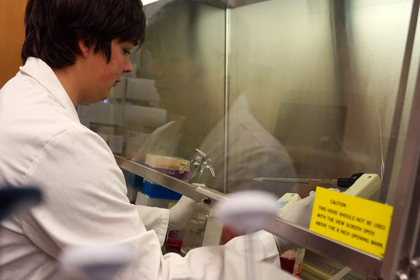Cells grown in a petri dish behave differently than cells that reside in a human being or animal. In order to help bridge the divide between these two worlds and gain a better understanding of what causes disease, Patrick Mullen works in both, comparing results he sees in the lab of Christopher Francklyn, Ph.D., an expert in protein synthesis enzymes, with animal studies conducted in the lab of Alicia Ebert, Ph.D., a biology professor known for her work with zebrafish.

Patrick Mullen, a Ph.D. student in the Neuroscience Graduate Program (Photo: LCOM Creative Services)
Cells grown in a petri dish behave differently than cells that reside in a human being or animal. In order to help bridge the divide between these two worlds and gain a better understanding of what causes disease, Patrick Mullen works in both, comparing results he sees in the lab of Christopher Francklyn, Ph.D., an expert in protein synthesis enzymes, with animal studies conducted in the lab of Alicia Ebert, Ph.D., a biology professor known for her work with zebrafish. Mullen, a Ph.D. student in the Neuroscience Graduate Program, is studying how gene mutations in tRNA synthetases – proteins essential for life in all organisms – cause a neurological disease called Charcot-Marie-Tooth Disease (CMT), with the goal of eventually honing in on a therapeutic target. Affecting up to 2.8 million people worldwide, CMT typically causes loss of muscle in the lower leg, numbness in the feet, and difficulty with balance that gets more severe over time. “Treatment options for many neurological diseases are not great, and these conditions can have truly debilitating effects,” Mullen says. “It’s important to try and figure out the mechanisms that underlie these diseases.”